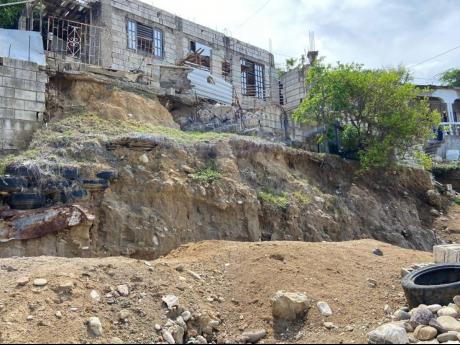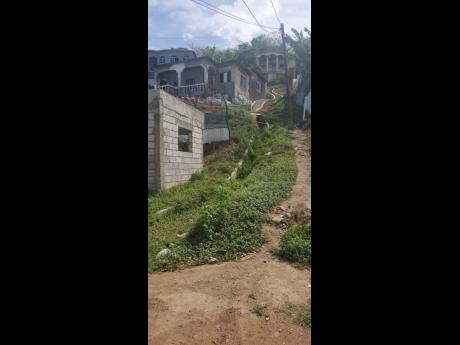Theresa Rodriguez-Moodie | Harbour View communities hanging by thread
Home today to over 13,000 residents, the construction of the formal community of Harbour View, located in east Kingston was completed in 1963. The low hills behind the community consist of unconsolidated sand and gravel which are unstable. The informal settlement in these hills originally started as a small farming community in the late 1970s. It then exploded with houses in the early 2000s and, along with the associated land clearing, led to more frequent landslides affecting lives and properties.
From as far back as the 1970s and ‘80s, members of the community recall geology students from The University of the West Indies doing research in those hills and sharing the importance of the vegetation to preserve the stability of the slopes. So, in 2007, members of the Harbour View Citizens Association (HVCA) contacted the then Kingston and St Andrew Corporation (KSAC) about the risks posed by the expanding informal settlement in these hills. The KSAC at the time declared the area behind Southern Cross Drive a no-build area and imposed a stop order. Building on these same slopes, however, continue until today.
In 2012, the Office of Disaster Preparedness and Emergency Management (ODPEM) recognised the issues associated with the unstable slopes and sought funding from the World Bank to carry out a project called the Management of Slope Stability in Communities (MoSSaiC) to address the situation. It is not clear if any of the relevant environmental and social assessments were done to support the design and implementation. Members of the HVCA recall that they were never consulted once the designs were done. The project finally began in 2014 and was executed by the National Works Agency (NWA) and completed in October 2015.
IMPROPERLY DESIGNED
The project involved the construction of steep, narrow open drains, some in a step formation, to capture runoff in a controlled manner eventually emptying into soak away systems. The system was improperly designed, however, and the water simply overwhelmed the drains and the soakaways. Rainfall events in October and November 2015 resulted in major flooding, the collapse of several walls and other property damage. Rainfall events since then in 2018 have caused further damage.
Who has suffered as a result of the informal settlement and this poorly designed intervention? Homeowners, with legal titles, from sections of the Harbour View Community, specifically Harbour Drive and Southern Cross Drive. Many of them are now retired, unable to sell and unable to rent due to the obvious damage and continuing threat. Most homeowners say they never had flooding issues prior to the implementation of the MoSSaiC project.
I visited the affected sections of the community in May 2022 and spoke with several of the retired citizens. One resident of Harbour Drive insisted I visit her home. She had purchased it in the early ‘90s and added a room to the rear of her property to earn rental income. Floods on multiple occasions have eroded her property’s foundation and now there is a gully behind her. She can no longer rent her property and is fearful she will lose her home and her investment or her life with the next big rain. As she spoke of her fears and frustration with the Government of Jamaica (GOJ), she cried.
NOTHING SIGNIFICANT DONE
Over the years, the community has written to its member of parliament, the Office of the Prime Minister, ODPEM, the World Bank, and the Kingston and St Andrew Municipal Corporation (KSAMC). In 2016, ODPEM committed to compensate the citizens who were adversely affected and do remedial work. To date, however, nothing significant has been done. In a visit to the community recently, Minister of Local Government and Rural Development Desmond McKenzie told the community, “You can’t expect the Government to do everything. If we are able to solve the problem of the drain and further erosion, then we would have gone a far way to resolving what threatens their property.” (Harbour Drive still on edge, The Gleaner May 27).
This dangerous situation was not created by the legal residents of Harbour View, but they continue to pay for the GOJ’s acts of omission in preventing the informal settlement and the subsequent poorly designed and implemented state-led intervention. Why should they be told it is now their problem?
The owners of homes damaged by previous flooding need to be compensated, and their properties repaired or rebuilt. The drainage infrastructure constructed by the MoSSaiC project also needs to be corrected to direct the flow of water away from people’s homes and into properly designed soak-away systems. These designs need to be accompanied by the appropriate hydraulic analyses, environmental and social assessments so as not to repeat previous mistakes. And people should not be allowed to continue living on these unstable hillsides as their lives are also at risk.
Theresa Rodriguez-Moodie, PhD, is an environmental scientist and the CEO of the Jamaica Environment Trust. Send feedback to jamaicaenvironmenttrust@gmail.com.



